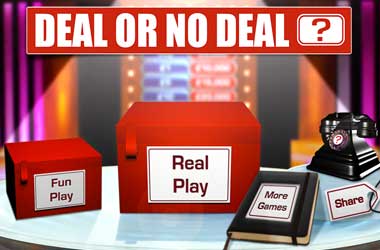Play Deal Or No Deal For Money
Deal or No Deal: The Slot Game is a Gaming1 creation that brings the world-famous game to your own computer in an original video slot game form. The goal remains the same: winning as much money as you can both on the reels and through the several bonuses features directly inspired by the original game. Slingo Deal or No Deal is a game that you’ll probably love if you already love Deal or No Deal in some capacity. And if you don’t it’s a game you’ll hate. It’s arguably more fun than some of the other Deal or No Deal games doing the rounds out there, like the scratch card or the numerous slots, but it’s still not great. Online casinos that offer Deal or No Deal for real money use most of the same rules used on the television game show. The player places a wager before the round and must attempt to discard all of the cases and hope that the last case remaining contains the biggest payout. Like in the television show, the player will have 26 boxes to choose from.
Deal or No Deal is the name of the popular game show which was created by the Dutch producer Endemol. The TV game is played with up to 26 cases (or boxes) which contain various amounts of money. The player must choose a case or box to take it off the game.
Deal or No Deal is play around the world sunce its success in Holland with versions in UK, USA, and India. Each country employ a twist on the standard format. You can read about Deal Or No Deal UK.
How to play Deal Or No Deal game
In some of the versions of Deal Or No Deal , there are around 20-26 prizes in most they contain cash, in some versions however contain prizes such as cars or false prizes. In the Austalian version their are 26 cases one of which has a car included as a prize.
The banker in the international versions of the game stops at various points, this is often at random after a predetermied time such as in the UK the banker comes into play after the first round is played.
The case which the player starts with varies with each version of the show, some allow for the contestent to choose for themselves others get it assigned to them.
In some versions of the game the Banker knows the locations of each of the cash amounts and prizes, this normally has an affect on the amount of money offered as part of the deal for the contestant.
The game also changes depending on the version at the end, some players who reject all the offers are given an opportunity to swap the case they hold for the last remaining one. In some versions side games are added, which can allow other contestents to guess the containers content and win some extra money.

Deal Or No Deal UK
The UK version of Deal Or No Deal of the TV Game, has twenty two red boxes each with the number 1 – 21 displayed, the contents of the box are not known either by Noel Edmunds, the contestants or the banker.
At the beginning of the shows, there are 22 contestants each stand behind a box, one of these players are usually selected by random to start the game. As the programme is only on for around 50 minutes, it normally takes 15 to 25 shows before they are selected to play.
Once the game starts, they choose one of the remaining 21 boxes to open, the aim is to eliminate the small amounts in the game, hoping of course they have a huge amount in theirs. Each of the box contestants will provide advice and some banter to make the show interesting.
There are in total six rounds in Deal Or No Deal UK , five boxes can be opened in the first and then three in all the other rounds. After a number of boxes are opened the banker will offer an amount to buy the players box. The amount is normally reflective of what is still available, so if a few large amounts have been removed the amount offered by the banker is low. The player choose whether or not to deal or no deal.
If the contestant deals then the game is over, but for the interest of viewers, the game is continued to see whether the play may have got a better deal if they had continued. If the player say no deal then they keep their box and proceed to the next round.
After the 6 rounds, there should only be two boxes remaining, one in play and the one the contestant has. If the player chooses to continue the game, they must take the cash amount which is left in their own box. The banker will give a last attempt deal, to swap the players box with that still in play. The swap is always offered when the top prize of £250,000 is still available.
Sometimes if a player has taken a deal early in the Deal or No Deal Game, they will be offered a chance known as the ‘bankers gamble’ to give back the amount the banker offered and open their box and winning whatever remained. This has happened controversially with the second highest winner in Deal Or No Deal UK where Alice Munday who had been dealt £17,500 previously and then won £250,000 when the banker offered the gamble.
The end of the year is always a busy time for teachers. I haven’t had the time to write a new Teaching Tip for you this week, so I decided to dig through the archives and repost this one from nearly four years ago. It’s a great game you can play with your class and it would work really well at your year-end class party.
My students really enjoy Classroom Deal or No Deal. The first time I played it, I didn’t have a Smartboard so I couldn’t use the website or one of the many online resources to play this game. Instead I just used a random number generator, the chalkboard, and a calculator (as a mock phone to the banker.)
After playing Deal or No Deal digitally with my class earlier this year, I must say that I prefer the low-tech way. It really allows me to ham it up.
Here’s how I prepared this game for the classroom.
Deal Or No Deal Game Online
First, I went to the Deal or No Deal website and copied down all the money amounts. Second, I found a random number generator on the Internet. Then I typed in all the money amounts into the generator and it produced the list you see below. I printed off the list and put it on my clipboard. On one side of the board I put up the chart of the money amounts like you see in the show.
1. 1000
2. 100000
3. 75
4. 400
5. 1
6. 50000
7. 400000
8. 750
9. 200000
10. 10
11. 50
12. 0.1
13. 300
14. 5000
15. 750000
16. 300000
17. 10000
18. 100
19. 25000
20. 5
21. 1000000
22. 75000
23. 500
24. 500000
25. 200
26. 25
I then drew 26 rectangles on the board and labelled them from 1 – 26. I asked the class to pick a suitcase. They picked case number 10. Ironically case ten held ten dollars. I didn’t tell them this, of course. I erased rectangle number 10 from the board and wrote it beside the number chart.
I then wrote the rounds on the board. Round 1 = 6 cases, 2 = 5 cases, 3 = 4 cases, 4 = 3 cases, 5 = 2 cases, 6 = 1 case, and every other round would also be one case to open.
I counted off the first six students by going up each row of desks. This way everyone knew where we would be stopping the first round. One by one I let the students pick a case. I then erased the chosen case from the board and the dollar amount it held from the chart. After we “opened” six cases, I pretended to talk to a banker by using a calculator as a phone. It was hilarious. I really hammed it up.

Each student had a piece of paper on their desk. If anyone liked the deal, all they had to do was write their name on the paper and bring it up to the front. I would then write the dollar amount under their name and stick it on the board. The point of the game was to come out with the most money at the end.
I had some students stop at round 2, 3, and 4, where the offers were $32 000, $64 000, and $99 000. It was exciting for everyone involved. By round 5 all of the big amounts had been knocked off and the offer fell. And just like on the show, I had students play all the way to the end and come away with the ten dollar prize.
Play Deal Or No Deal For Money
The sole winner in the class was the person who took the deal of $99 000. I had three people tie for second place because they took the $64 000 deal and two students tied for third place. I think everyone really enjoyed the afternoon’s game. I know I sure did. I was surprised at how well it actually turned out.
I even gave out prizes for the winners. It was a lot of fun and something I now do with my class every year. Oh, and I forgot to mention, it even teaches probability (but school can just be fun sometimes, can’t it?)
Related articles
Play Deal Or No Deal For Money Online
- Teaching Tip Tuesday Archive (over 100 useful tips)
- Summer Homework (Have your students write you a letter over the summer)
- 5 Shading Techniques (A great art lesson)